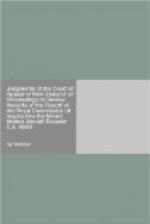The first two flights in February 1977 took place with the necessary approval of the Civil Aviation Division of the Ministry of Transport and after clearance with the United States naval authorities who control the air space in the vicinity of McMurdo Station. Those flights followed a computer-controlled flight track to Cape Hallett thence directly over Ross Island and Mt. Erebus at the stipulated minimum height of 16,000 feet to the McMurdo waypoint. The co-ordinates of that waypoint had been written correctly into the flight plan as 77 deg. 53’ south latitude and 166 deg. 48’ east longitude. Three of the pilots who flew to the Antarctic in November 1977 were available to give evidence and, like the two earlier pilots, they agreed that at that time the flight plan followed a track from Cape Hallett to the McMurdo area which passed virtually overhead Mt. Erebus. However then and on subsequent occasions the sightseeing aircraft to the McMurdo area arrived in the general vicinity of Cape Hallett to find clear air further on and took the opportunity of visual meteorological conditions to veer laterally from the direct computer flight track from Cape Hallett by tracking to the west along the coast of Victoria Land and eventually down McMurdo Sound over the flat sea ice. Ross Island was thus left to the east while near the head of the Sound the aircraft would turn left in order to fly over Scott and McMurdo bases and in the vicinity of Ross Island so that a view would be obtained of Mt. Erebus and the other three mountains there.
When the decision was made to operate the series of flights to take place at the end of 1977 a change was made with the approval of the Civil Aviation Division to permit flights below 16,000 feet down to 6,000 feet in a specified sector south of Ross Island and subject to such criteria as a cloud base no lower than 7,000 feet, clear visibility for at least 20 miles and descent under ground radar guidance. It has been mentioned that similar criteria applied, officially at least, until the time of the fatal crash. But the written directions were interpreted by some pilots as leaving them with a degree of discretion to go lower in ideal weather conditions.
Then in September 1978 steps were taken to print a flight plan for each Antarctic journey from a record stored in the Air New Zealand ground based planning computer. And it is at this stage that the longitude co-ordinate for the southernmost waypoint was fed into the ground computer as 164 deg. 48’ E.




